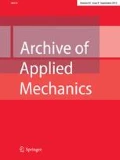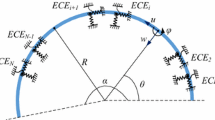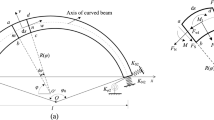Abstract
In this paper, a modified variational method is developed to study the free and forced vibration of coupled straight–curved beam systems with an arbitrary number of eccentric discontinuities (EDs). Based on the generalized shell theory, the kinetic and potential functional of the curved beam with arbitrary subtended angles is formulated. Since the shear and inertial (or radial–tangential–rotational coupling) effects are included for the curved beam, the longitudinal vibration is also introduced to the energy functional for a straight Timoshenko beam. Using corresponding coordinate transformations, the Lagrange multiplier method and least-square weighted residual method are employed to impose the continuity constraints on the internal interfaces and boundaries among the straight and curved beams. The proposed method allows a flexible choice of the admissible functions and can be used for various combinations of the straight and curved beams to model corresponding engineering structures. Concentrated forces, uniformly distributed loads and space-dependent loads are considered to demonstrate great efficiency and accuracy of the present approach for the forced as well as the free vibration of the coupled system. Most of the present results are compared with those from finite element program ANSYS, and good agreement is observed. Influences of the EDs on the dynamic responses of the coupled system are also examined.










Similar content being viewed by others
References
Hajianmaleki, M., Qatu, M.S.: Vibrations of straight and curved composite beams: a review. Compos. Struct. 100, 218–232 (2013)
Zhang, Z., Huang, X., Zhang, Z., Hua, H.: On the transverse vibration of Timoshenko double-beam systems coupled with various discontinuities. Int. J. Mech. Sci. 89, 222–241 (2014)
Mokhtari, A., Mirdamadi, H.R.: Study on vibration and stability of an axially translating viscoelastic Timoshenko beam: non-transforming spectral element analysis. Appl. Math. Model. 56, 342–358 (2018)
Mei, C.: Studying the effects of lumped end mass on vibrations of a Timoshenko beam using a wave-based approach. J. Vib. Control 18(5), 733–742 (2012)
Lei, Z., Su, J., Hua, H.: Longitudinal and transverse coupling dynamic properties of a Timoshenko beam with mass eccentricity. Int. J. Struct. Stab. Dyn. 17(7), 1–17 (2017)
Su, J., Lei, Z., Hua, H.: Axial-bending coupling vibration of mass eccentric double-beam system with discrete elastic connections. Proc. Inst. Mech. Eng. Part M J. Eng. Marit. Environ. 231(2), 555–568 (2017)
Rao, S.S., Sundararajan, V.: In-plane flexural vibrations of circular rings. J. Appl. Mech. ASME 36, 620–625 (1969)
Huang, X., Hua, H., Wang, Y., Du, Z.: Research on wave mode conversion of curved beam structures by the wave approach. J. Vib. Acoust. 135(3), 031014 (2013)
Thomas, D.L., Wilson, J.M., Wilson, R.R.: Timoshenko beam finite-elements. J. Sound Vib. 31, 315–330 (1973)
Raveendranath, P., Singh, G., Rao, G.V.: A three-node shear-flexible curved beam element based on coupled displacement field interpolations. Int. J. Numer. Methods Eng. 51, 85–101 (2001)
Zhu, Z.H., Meguid, S.A.: Vibration analysis of a new curved beam element. J. Sound Vib. 309(1), 86–95 (2008)
Yang, F., Sedaghati, R., Esmailzadeh, E.: Free in-plane vibration of general curved beams using finite element method. J. Sound Vib. 318(4), 850–867 (2008)
Cannarozzi, M., Molari, L.: A mixed stress model for linear elastodynamics of arbitrarily curved beams. Int. J. Numer. Methods Eng. 74, 116–137 (2008)
Kim, J.G., Park, Y.K.: Hybrid-mixed curved beam elements with increased degrees of freedom for static and vibration analyses. Int. J. Numer. Methods Eng. 68, 690–706 (2006)
Kim, J.G., Lee, J.K.: Free-vibration analysis of arches based on the hybrid-mixed formulation with consistent quadratic stress functions. Comput. Struct. 86, 1672–1681 (2008)
Luu, A.T., Kim, N.I., Lee, J.: Isogeometric vibration analysis of free-form Timoshenko curved beams. Meccanica 50(1), 169–187 (2015)
Chen, C.N.: DQEM analysis of in-plane vibration of curved beam structures. Adv. Eng. Softw. 36(6), 412–424 (2005)
He, X.T., Li, X., Li, W.M., Sun, J.Y.: Bending analysis of functionally graded curved beams with different properties in tension and compression. Arch. Appl. Mech. 89, 1973–1994 (2019)
Ansari, R., Gholami, R., Sahmani, S.: Size-dependent vibration of functionally graded curved microbeams based on the modified strain gradient elasticity theory. Arch. Appl. Mech. 83, 1439–1449 (2013)
Ebrahimi, F., Barati, M.R.: A nonlocal strain gradient refined beam model for buckling analysis of size-dependent shear-deformable curved FG nanobeams. Compos. Struct. 159, 174–182 (2017)
Ebrahimi, F., Barati, M.R.: Size-dependent dynamic modeling of inhomogeneous curved nanobeams embedded in elastic medium based on nonlocal strain gradient theory. Proc. Inst. Mech. Eng. Part C J. Mech. Eng. Sci. 231(25), 4457–4469 (2017)
Ebrahimi, F., Barati, M.R.: Vibration analysis of piezoelectrically actuated curved nanosize FG beams via a nonlocal strain-electric field gradient theory. Mech. Adv. Mater. Struct. 25(4), 350–359 (2016)
Ebrahimi, F., Barati, M.R., Mahesh, V.: Dynamic modeling of smart magneto-electro-elastic curved nanobeams. Adv. Nano Res. 7(3), 145 (2019)
Kang, B., Riedel, C.H., Tan, C.A.: Free vibration analysis of planar curved beams by wave propagation. J. Sound Vib. 260(1), 19–44 (2003)
Kang, B., Riedel, C.H.: On the validity of planar, thick curved beam models derived with respect to centroidal and neutral axes. Wave Motion 49(1), 1–23 (2012)
Wu, J.S., Lin, F.T., Shaw, H.J.: Free in-plane vibration analysis of a curved beam (arch) with arbitrary various concentrated elements. Appl. Math. Model. 37(14), 7588–7610 (2013)
Arici, M., Granata, M.F., Margiotta, P.: Hamiltonian structural analysis of curved beams with or without generalized two-parameter foundation. Arch. Appl. Mech. 83(12), 1695–1714 (2013)
Chouvion, B., Fox, C.H.J., Mcwilliam, S., Popov, A.A.: In-plane free vibration analysis of combined ring-beam structural systems by wave propagation. J. Sound Vib. 329(26), 5087–5104 (2010)
Zhao, Y., Kang, H.: In-plane free vibration analysis of cable–arch structure. J. Sound Vib. 312(3), 363–379 (2008)
Su, J., Zhou, K., Qu, Y., Hua, H.: A variational formulation for vibration analysis of curved beams with arbitrary eccentric concentrated elements. Arch. Appl. Mech. 88(7), 1089–1104 (2018)
Kim, J.G., Lee, J.K., Yoon, H.J.: On the effect of shear coefficients in free vibration analysis of curved beams. J. Mech. Sci. Technol. 28(8), 3181–3187 (2014)
Magrab, E.B.: Vibrations of Elastic Systems: With Applications to MEMS and NEMS. Springer, Berlin (2012)
Jeffery, A., Dai, H.H.: Handbook of Mathematical Formulas and Integrals, 4th edn. Academic Press, California (2008)
Fu, Z., Hua, H.: Modal Analysis Theory and Application. Shanghai Jiao Tong University Press, Shanghai (2000)
Qu, Y., Chen, Y., Long, X., Hua, H., Meng, G.: Free and forced vibration analysis of uniform and stepped circular cylindrical shells using a domain decomposition method. Appl. Acoust. 74(3), 425–439 (2013)
Acknowledgements
This work was supported by the National Natural Science Foundation of China (Grant nos. 51504121 and 51774161).
Author information
Authors and Affiliations
Corresponding author
Additional information
Publisher's Note
Springer Nature remains neutral with regard to jurisdictional claims in published maps and institutional affiliations.
Appendices
Appendix A: Generalized mass and stiffness matrices of the coupled beam system
The disjoint generalized mass and stiffness matrices of the coupled straight–curved beam system are, respectively, assembled as
where \(\mathbf{M }_{c,i}\) and \(\mathbf{K }_{c,i}\) (\(i\in \left[ {1,N_{c} } \right] )\) are the disjoint generalized mass and stiffness matrices for the curved beam component, respectively. For more details, the readers may refer to Ref. [23]. The generalized mass and stiffness matrices of the ith straight beam segment can be given by
The elements of the mass matrices are:
The elements of the stiffness matrices are:
According to the organization of the elements in the generalized displacement vector, assembling all interface matrices of the straight beam component leads to the generalized interface matrices \({\mathbf{K}}_{\lambda }^{s}\) and \({\mathbf{K}}_{\kappa }^{s}\) of the straight beam component. The interface matrix \({\mathbf{K}}_{\lambda }^{i}\) of the straight beam at the interface located at \(x=x_{i}\) is given by
The detailed elements of the interface matrix \({\mathbf{K}}_{\lambda }^{i}\) are:
The generalized matrix \({\mathbf{K}}_{\kappa }^{i}\) due to the least-square weighted terms at the interface located at \(x=x_{i}\) is given below
where the detailed elements are obtained by
Appendix B: Generalized interface stiffness matrices at the joints of the straight and curved beam components
The interface matrix \({\mathbf{K}}_{\lambda }^{s,c} \) at the interface between the straight and curved beam is expressed as
The detailed elements of the interface matrix \({\mathbf{K}}_{\lambda }^{i}\) are:
The generalized matrix \({\mathbf{K}}_{\kappa }^{s,c}\) due to the least-square weighted terms at the interface between the straight and curved beam is given below
where the detailed elements are obtained by
For the generalized mass and stiffness matrices of EDs, the readers may refer to Ref. [23]
Rights and permissions
About this article
Cite this article
Su, J., Zhang, K., Zhang, Q. et al. Vibration analysis of coupled straight–curved beam systems with arbitrary discontinuities subjected to various harmonic forces. Arch Appl Mech 90, 2071–2090 (2020). https://doi.org/10.1007/s00419-020-01709-z
Received:
Accepted:
Published:
Issue Date:
DOI: https://doi.org/10.1007/s00419-020-01709-z




